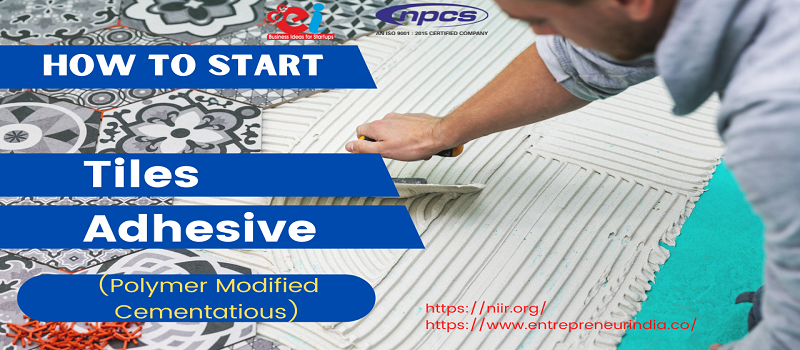A tile adhesive is one of a variety of substances used to join tiles together. Tile adhesives come in several forms, including pneumatic and plastic injection guns, tubes and trowels. The most common tile adhesive today is polymer modified cementitious composites (PMCCs), which are usually pumped into molds that make up a certain area of a floor or wall. Other options include epoxy, hot-melt and natural cement tile adhesives. PMCC tile adhesives work well for indoor residential installations where moisture levels are not too high, as well as for swimming pools and commercial properties like gyms. In some cases, grout joints might be necessary when installing PMCC tile adhesives; often these joints can be filled with other types of cements as well.
Visit this Page for More Information: Start a Business in Adhesives and Sealants Industry
Production process of Tile Adhesives:
Step 1: Selecting raw materials,
Step 2: Mixing raw materials, and
Step 3: Powder feeding system are all steps in the production of polymer modified cementatious tiles adhesive.
Constant flow production defines the manufacturing process, which necessitates continuous raw material delivery and fluidization. A piece of powder is picked up and then delivered into an atomizer, where it is hung in air as particles are beaten in continuous flow production. After that, a portion of the powder is dispersed and blended in a fluidizer.
Related Feasibility Study Reports: Adhesives and Sealants, Industrial Adhesives
Finally, the mix is delivered to a tank with the appropriate amount of water for liquid mixing, which includes a pelleting mechanism. The efficiency of a fluidized bed has been noted to be dependent on efficient electrical equipment such as an agitator and a blower, without which it may fail at times. Compactors are also sometimes used to make pellets of a specific size. This polymer modified cementatious tiles adhesive is ready to use as a cement additive in concrete mixtures or precast concrete components (fibre reinforced plastic goods) with either glass or mineral wool reinforcing.
Read Similar Articles: Adhesives and Sealants
Uses
Tiles adhesives are used to bond different substrates, such as ceramic, granite and marble surfaces. The applications include kitchen backsplashes, bathroom walls and floors, shower stalls, tub surrounds and other surfaces requiring waterproofing. The glue is also ideal for countertops that consist of multiple materials or natural stone. This bonding material can be applied to one or both sides, depending on your project requirements. It won’t crack, chip or peel away.
Read our Books Here: Gums, Adhesives & Sealants Technology (With Formulae)
Benefits of Starting Tiles Adhesive Manufacturing Business
On account of demand, it is a new industry in India. Its demand is growing at a high rate due to increased use by various industries including construction, infrastructure and real estate. There is an untapped market for tiles adhesive that can be exploited by new entrepreneurs. It requires less investments as compared to normal cement business and have better profit margins. Trained manpower and manufacturing equipment availability makes it easy for entrepreneurs to set up their units in record time which will lead to a faster growth rate. Mini-plants or small scale plants are available as well with cost effective price range and hence also helps entrepreneurs to start their own tile adhesive business in lesser investment.
Related Project Report: Polymer Modified Cementitious Tile Adhesives
Market outlook
The Tile Adhesive Market is predicted to expand at a rate of roughly 8% per year. Demand for quick-fix adhesives and long-lasting tile glue is continuing to grow. Furthermore, increased awareness of the benefits of titles adhesive, such as its durability and time-saving factor due to its quick mixing ability, is driving demand for tiles adhesive.
In recent years, as a huge number of people have begun to migrate from rural to urban regions in pursuit of jobs, the use of sophisticated adhesives in the construction of residences and commercial structures has expanded in developing countries. As a result, the real estate market has grown, as has the usage of tile adhesives in the construction of homes and businesses.
Read our Book Here: Adhesives Formulary Handbook (Second Edition)
Furthermore, because today’s consumers seek a more stylish and appealing interior in their homes, tiles adhesive is critical in ensuring the tiles’ long-term resilience and endurance.
Watch other Informative Videos: Adhesives and Sealants, Industrial Adhesives, Glues, Gums and Binders, Synthetic Resin, Resins (Guar Gum, Adhesive [Fevicol Type], Hot Melt Adhesives)
Asia Pacific Tiles Adhesive Market Outlook
The largest market for tile adhesive is Asia Pacific. More than 40% of the global tile adhesive market is accounted for by the Asia Pacific region. Demand in Asia Pacific is expected to develop fast during the estimated period as the number of operations in the end-use industry grows (2021-2031).
The tile adhesive industry in Asia Pacific is dominated by China and India. The number of small and large-scale commercial construction projects has increased as international firms expand their investment in India’s information and technology industries, resulting in an increase in the use of tiles adhesive.
Aside from that, the Indian government has created the Make in India initiative to support the local chemical sector by granting tax relief for infrastructure improvements as well as tax incentives for R&D projects. These are the elements that are propelling the tiles adhesive market in India.
See More Links:
Start a Business in Potential Countries for Doing Business
Best Industry for Doing Business
Business Ideas with Low, Medium & High Investment
Looking for Most Demandable Business Ideas for Startups
Start a Business in Middle East
Related Market Research Reports

